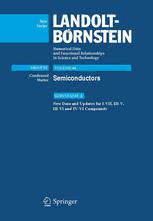
New Data and Updates for I-VII, III-V, III-VI and IV-VI Compounds PDF
Preview New Data and Updates for I-VII, III-V, III-VI and IV-VI Compounds
Landolt-Börnstein / New Series Landolt-Börnstein Numerical Data and Functional Relationships in Science and Technology New Series Editor in Chief: W. Martienssen Units and Fundamental Constants in Physics and Chemistry Elementary Particles, Nuclei and Atoms (Group I) (Formerly: Nuclear andParticle Physics) Molecules and Radicals (Group II) (Formerly: Atomic and Molecular Physics) Condensed Matter (Group III) (Formerly: Solid State Physics) Physical Chemistry (Group IV) (Formerly: Macroscopic Properties of Matter) Geophysics (Group V) Astronomy and Astrophysics (Group VI) Biophysics (Group VII) Advanced Materials and Technologies (Group VIII) Some of thegroupnames have beenchangedto provide abetterdescription oftheircontents. Landolt-Börnstein Numerical Data and Functional Relationships in Science and Technology New Series / Editor in Chief: W. Martienssen Group III: Condensed Matter Volume 44 Semiconductors Subvolume A: New Data and Updates for I-VII, III-V, III-VI and IV-VI Compounds Editor: U. Rössler Authors: T. Dietl, W. Dobrowolski, E.C. Fernandes da Silva, B. Hönerlage, B.K. Meyer, U. Rössler, T. Story ISSN 1615-1925(CondensedMatter) ISBN 978-3-540-48528-5Springer Berlin HeidelbergNew York e-ISBN 978-3-540-48529-2 LibraryofCongressCataloginginPublicationData ZahlenwerteundFunktionenausNaturwissenschaftenundTechnik,NeueSerie EditorinChief:W.Martienssen Vol.III/44A:Editor:U.Rössler Atheadoftitle:Landolt-Börnstein.Addedt.p.:Numericaldataandfunctionalrelationshipsinscienceandtechnology. TableschieflyinEnglish. IntendedtosupersedethePhysikalisch-chemischeTabellenbyH.LandoltandR.Börnsteinofwhichthe6thed.beganpublicationin1950undertitle: ZahlenwerteundFunktionenausPhysik,Chemie,Astronomie,GeophysikundTechnik. Vols.publishedafterv.1ofgroupIhaveimprint:Berlin,NewYork,Springer-Verlag Includesbibliographies. 1.Physics–Tables.2.Chemistry–Tables.3.Engineering–Tables. I.Börnstein,R.(Richard),1852-1913.II.Landolt,H.(Hans),1831-1910. III.Physikalisch-chemischeTabellen.IV.Title:Numericaldataandfunctionalrelationshipsinscienceandtechnology. QC61.23502'.12 62-53136 Thisworkissubjecttocopyright.Allrightsarereserved,whetherthewholeorpartofthematerialisconcerned,specificallytherightsoftranslation,rep- rinting,reuseofillustrations,recitation,broadcasting,reproductiononmicrofilmorinotherways,andstorageindatabanks.Duplicationofthispublica- tionorpartsthereofispermittedonlyundertheprovisionsoftheGermanCopyrightLawofSeptember9,1965,initscurrentversion,andpermissionfor usemustalwaysbeobtainedfromSpringer-Verlag.ViolationsareliableforprosecutionactunderGermanCopyrightLaw. SpringerisapartofSpringerScience+BusinessMedia springeronline.com ©Springer-VerlagBerlinHeidelberg2008 PrintedinGermany Theuseofgeneraldescriptivenames,registerednames,trademarks,etc.inthispublicationdoesnotimply,evenintheabsenceofaspecificstatement,that suchnamesareexemptfromtherelevantprotectivelawsandregulationsandthereforefreeforgeneraluse. ProductLiability:Thedataandotherinformationinthishandbookhavebeencarefullyextractedandevaluatedbyexpertsfromtheoriginalliterature. Furthermore,theyhavebeencheckedforcorrectnessbyauthorsandtheeditorialstaffbeforeprinting.Nevertheless,thepublishercangivenoguarantee forthecorrectnessofthedataandinformationprovided.Inanyindividualcaseofapplication,therespectiveusermustcheckthecorrectnessbyconsulting otherrelevantsourcesofinformation. Coverlayout:ErichKirchner,Heidelberg Typesetting:AuthorsandRedaktionLandolt-Börnstein,Darmstadt PrintingandBinding:AZDruck,Kempten SPIN:11672517 63/3020-543210–Printedonacid-freepaper Preface of the editor ThelastupdateoftheLandolt-BörnsteinNewSeriesonsemiconductorphysicsandtechnology,consisting ofthefivesubvolumesIII/41AtoIII/41E,waspublishedintheyearsbetween1998and2002.Insteadofa revisededitionofthepreviousvolumesIII/17AtoIII/17I(publishedbetween1982and1985)andthesup- plementaryvolumesIII/22AandIII/22B(publishedbetween1987and1989)oranewsupplement,thislast updatefollowedanewconceptofprovidingaCD-ROMofeachsubvolumewithallupdatesandarevised version of the corresponding old data besides the printed version of the new data. Thus, all collected data was made available tothe user ina very compactand consistent form. In the more than five years since this last update, the field of semiconductor research has continuously grown.Bothnewdataofstandardsemiconductorsand,evenmore,dataonavarietyofnewmaterialshave beenpublished.Inthemeantime,thepublisherhaddecidedtodeveloptheLandolt-Börnsteindatacollection into an electronic major reference work. Therefore, the Springer Verlag decided in 2005 to start a new update project with the intention to complete the online database in an almost continuous way. The first input, containing data on semiconductors with tetrahedral coordination of the I-VII, II-VI and III-V, III- VIandIV-VIcompoundfamilies,willgoonlinein2008andalsoappearinprintedformastwosubvolumes III/44AandIII/41B.Furtherdatashallfollowonashorttimescale.Thecontentsofthetwoprintedsubvo- lumes are: Subvolume III/44A: (mspace) New Data and Updates for I-VII,III-V, III-VI and IV-VI Compounds; Subvolume III/44B: (mspace) New Data and Updates for II-VI Compounds. ThefirstsubvolumeIII/44AcontainsaSystematicsofSemiconductorProperties,whichshouldhelpthe non-specialist user to understand the meaning of the material parameters. The documents of both subvo- lumes, including links to older material and to the original citations, will be available on www.landolt- boernstein.com, where also the Landolt-Börnstein e-catalog and a User Guide describing different ways of accessing theelectronic data ofLandolt-Börnsteinare presented. These two subvolumes would not have been accomplished without the diligence and patience of the authors,whoseeffortsandexpertisehavetobeacknowledgedinthefirstplace.Everysinglepageanddocu- ment had to pass the visual control of Tobias Schwaibold of the Landolt-Börnstein editorial office several times.Dr.RainerPoerschkecontributedmuchtotheprojectbyhiscoordinationandencouragingguidance. I amgrateful toboth of them for theircooperation. Regensburg, February 2008 The Editor Editor U.Rössler InstitutfürTheoretischePhysik UniversitaetRegensburg 93040Regensburg,Germany [email protected] Authors T.Dietl LaboratoryforCryogenicandSpintronicResearch InstituteofPhysics,PolishAcademyofSciences al.Lotnikow32/46, 02-668Warszawa,POLAND [email protected] W.Dobrowolski LaboratoryforCryogenicandSpintronicResearch InstituteofPhysics,PolishAcademyofSciences al.Lotnikow32/46, 02-668Warszawa,POLAND E.C.FernandesdaSilva InstitutodeFisica LaboratoriodeNovosMateriaisSemicondutores UniversidadedeSaoPaulo RuadoMatao,travessaR,187 05508-900Butanta,SaoPaulo,SP,Brasil [email protected] B.Hönerlage IPCMS/GONLO,BP43 23,rueduLoess 67034Strasbourgcedex2,France [email protected] B.K.Meyer 1.PhysikalischesInstitut UniversitaetGiessen Heinrich-Buff-Ring16 35392Giessen,Germany [email protected] U.Rössler InstitutfürTheoretischePhysik UniversitaetRegensburg 93040Regensburg,Germany [email protected] T.Story LaboratoryforCryogenicandSpintronicResearch InstituteofPhysics,PolishAcademyofSciences al.Lotnikow32/46, 02-668Warszawa,POLAND Landolt-Börnstein: Editorial Office Gagernstr.8,D-64283Darmstadt,Germany fax:+49(6151)171760 e-mail:[email protected] Internet:www.landolt-boernstein.com Contents III/44A Semiconductors: New Data and Updates for I-VII, III-V, III-VI and IV-VI Compounds SystematicsofSemiconductorData....................................................1 1. StructuralProperties ..................................................................X 2. ThermalandThermodynamicProperties....................................................X 3. ElectronicProperties..................................................................X 4. ImpuritiesandDefects.................................................................X 5. LatticeProperties ....................................................................X 6. TransportProperties ..................................................................X 7. OpticalProperties....................................................................X 8. MagneticProperties ..................................................................X 9. References .........................................................................X IndexofSubstances.....................................................................X ListofSymbols ........................................................................X ConversionFactors .....................................................................X DataforI-VII,III-V,III-VIandIV-VICompounds(sortedbyelementsystem)......................X Systematicsof Semiconductor Data 1 Systematics of Semiconductor Data Data extract from Landolt-Börnstein III/44A: Semiconductors – New Data and Updates for I-VII, III-V, III-VI and IV-VI Compounds Introduction Intrinsicsemiconductorsarecharacterizedbyasingle-electronenergyspectruminwhich,atzerotempera- ture,thetopmostoccupied(orvalenceband)statesareseparatedbyanenergygapE fromthelowestunoc- g cupied (or conduction band) states [76A, 91S, 93I, 96K, 96Y]. The energy gaps of semiconductors are between zero and a few eV, thus covering the spectral range from the far-infrared to the near ultra-violet, forwhichsemiconductorsaretransparent.Whilebeinginsulatorsatverylowtemperature,withincreasing temperatureelectronscanbethermallyexcitedacrossthegap,thusgivingrisetoactivatedintrinsicconduc- tivity.Theelectronicpropertiesofsemiconductorscanbemodifiedbylatticedefects.Inparticular,impuri- ties which replace the host atoms become effective by creating electronic states in the energy gap from which carriers can be thermally excited to the conduction or valence band. The energygap and the possi- bilitytomanipulatetheelectronicpropertiesbydopingaretheessentialfeaturesfortheopticandelectronic device applicationsof semiconductors. 1. Structural Properties A crystal structure isthe periodic arrangement of single atoms (mono-atomic lattice) orgroups ofatoms (latticewithbasis)attachedtothepointsofaBravaislattice.TheBravaislatticeisdefinedbylatticepoints given bythe lattice vectors Rn ¼n1a1þn2a2þn3a3 ð1Þ withintegern,i=1,2,3andprimitivetranslationsa ,a ,anda [57K2,76A,93I,96K].Inthreedimen- i 1 2 3 sions14differentBravaislatticescanberealized.Inamono-atomiclatticeeachlattivepointisoccupiedby oneatomofagivenkind.Inalatticewithbasis,thesublatticeatomsareplacedatatomicpositionstsrela- tivetoeachlatticepoint,wheretheindexsrefers totheatomsofthebasis.ForagivenBravaislatticethe wholespacecanbethoughttobefilledwithoutvoidsbyidenticalvolumesaroundeachlatticepointorby replicaofthisvolumeobtainedfromtranslationsbylatticevectorsRn.Thereisnouniquewaytodefinethis volumeorprimitivecell(orunitcell).Aspecialchoice,reflectingthesymmetryoftheBravaislattice,isthe Wigner-Seitzcell.Itisdefinedasthevolumearoundalatticepointwhosespatialpointsareclosertothis one than to any other lattice point. The Wigner-Seitz cell is enclosed by the symmetry planes of the lines connectinga lattice point with itsnearest and next nearestneighbors. Anotherchoiceoftheunitcellisthatofaparallelepipedspannedbythreeindependentvectorsa,b,andc whichdefinethecrystalaxes.Withrespecttothesethelatticeischaracterizedbylatticeparameterswhich are the lengths a, b, and c and the angles α, β and γ between pairs of these vectors (see Fig. 1.1). Lattice constants depend on temperature and pressure (see Chap. 2. Thermal and Thermodynamic Properties). Semiconductorsgrownfromnaturalmaterialaredisorderedduetotheisotopeabundance.Using,however, isotopically pure material the lattice constants show isotope dependence [96Y]. Fig.1.1. Crystalaxesa,b,andcandthemeaningoflatticeparameters. Landolt-Börnstein DOI:10.1007/978-3-540-48529-2_1 NewSeriesIII/44A #Springer2008
